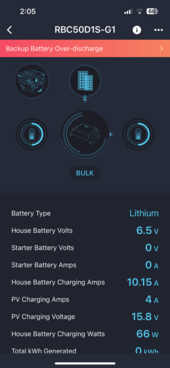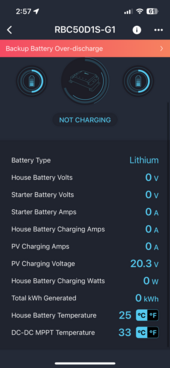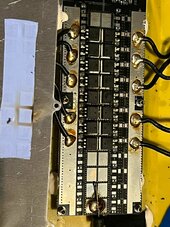So I did this. I went back to the supplier and figured I'd make them an offer on the dead 135 Ah battery and see If I can performer Frankenstein and bring it back to life. They were happy to take $50 cash as I think it was just going to end up being be a door stop. I figured that if necessary I might be able to buy a new BMS and all would be good.
Now I've just cracked the case and first impressions it all looked neat. Then I noticed a bunch (5) 14-AWG cables going to each terminal. I thought that odd but put it down to an unusual BMS. (note that I'm a novice in this area, those with more knowledge will have picked up immediately what kind of battery this is!)
The cells were nicely wrapped and foam stand offs held the pack firmly in place inside the battery box. I carefully removed all the foam pieces and began to pry the pack out of the box. Let me tell you it was firmly held in place! I used a piece of timber to gently work around each side gradually applying pressure to realise the pack from the case. I figured they factory had just used a generous amount of adhesive to hold it in place as it was never intended to be taken out. It eventually started to seperate and I could begin slide the pack out from the enclosure.
Now when I peaked inside I was surprised to see that what appears to be a thin piece of aluminium was being left behind and tearing off the bottom of the cells. I put on some thick rubber gloves and carefully removed the aluminium from the enclosure and removed the battery pack.
Now it became evident what type of battery I have, it's a 12.8V 135Ah cylindrical cell pack. He comprises of 32 individual batteries each measuring approx 33mm x 140mm. From googling the dimensions, my best guess is that it's a 32140 cell. Using chatGPT it tells me my battery would be
4 sets of 8 batteries in series-parallel to create a 12.8V battery with a total capacity of 135Ah and 1728Wh.
Now that I can see what battery I have, can anyone kindly give some pointers to problem solve why after a very brief short, it is dead and how to diagnose the issue? I have attempted many times to kick start the BMS with various 12v supplies without success. My initial hope that I would was that I would be dealing with four 'normal' cells and I would just purchase a new BMS and hopefully be back up and running. Seeing this pack of cylindrical cells has thrown me a curveball and I don't know how to start trouble shooting.
One important piece of advice that I should seek in the beginning is apart from common sense what are the particular dangers of this type of battery configuration? Also, is the blue wrap holding the cells together or can I carefully remove it?
TLDR: I have what appears to be a dead battery consisting of 32 cylindrical cells. What steps should I take to diagnose why won't take a charge. (I've tried all the normal jumpstarting techniques)
As pictures paint 1000 words here is a
gallery showing the guts of my battery.






